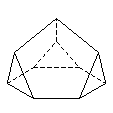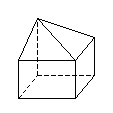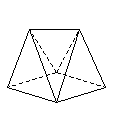Heptahedron
A heptahedron (plural: heptahedra) is a polyhedron having seven sides, or faces.
A heptahedron can take a surprising number of different basic forms, or topologies. Probably most familiar are the hexagonal pyramid and the pentagonal prism. Also notable is the tetrahemihexahedron, whose seven equilateral triangle faces form a rudimentary projective plane. No heptahedra are regular.
Topologically distinct heptahedra
Convex
There are 34 topologically distinct convex heptahedra, excluding mirror images.[1] (Two polyhedra are "topologically distinct" if they have intrinsically different arrangements of faces and vertices, such that it is impossible to distort one into the other simply by changing the lengths of edges or the angles between edges or faces.)
An example of each type is depicted below, along with the number of sides on each of the faces. The images are ordered by descending number of six-sided faces (if any), followed by descending number of five-sided faces (if any), and so on.

|

|

|

|

|

|

|

|
 Hexagonal pyramid
|

|

|

|
 Pentagonal prism
|

|

|

|

|

|

|

|

|

|

|

|

|

|

|
 Elongated triangular pyramid
|

|

|

|

|

|

|
Concave
      Six topologically distinct concave heptahedra (excluding mirror images) can be formed by combining two tetrahedra in various configurations. The third, fourth and fifth of these have a face with collinear adjacent edges, and the sixth has a face that is not simply connected. | |
  13 topologically distinct heptahedra (excluding mirror images) can be formed by cutting notches out of the edges of a triangular prism or square pyramid. Two examples are shown. |
  A variety of non-simply-connected heptahedra are possible. Two examples are shown. |
References
External links
- Polyhedra with 4–7 Faces by Steven Dutch
- Weisstein, Eric W., "Heptahedron", MathWorld.
| ||||||||||||||